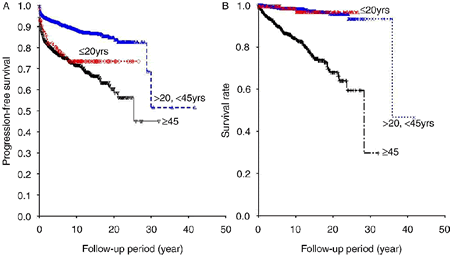ICEECE2012 Poster Presentations Thyroid cancer (108 abstracts)
Therapeutic outcome and prognosis in young patients with papillary and follicular thyroid cancer
J. Lin , C. Huang , T. Chao , C. Hseuh , K. Lin & S. Lin
Chang Gung Memorial Hospital, Chang Gung University, Taoyuan Hsien, Taiwan.
The aims of this study are to assess the clinical characteristics of papillary and follicular thyroid cancer in young patients. We performed a retrospective analysis of 116 patient aged 20 years who underwent thyroidectomy and a mean follow-up of 11.1±0.6 years. There were 28 (24.1%) patients were classified into the residual cancer or relapse groups. Two of the 28 patients died of thyroid cancer. Thirteen patients who showed relapsed underwent 131I whole body scan; six of the 13 patients were diagnosed with distant metastases. Among the young patients, the 5- and 10-year progression-free survival rates were 79.1 and 73.4%, respectively. In conclusion, the progression-free survival in young patients with papillary and follicular thyroid cancer was lower than the patients of age 20–45 years; otherwise, cancer survival higher than age group over or equal 45 year-old.
Declaration of interest: The authors declare that there is no conflict of interest that could be perceived as prejudicing the impartiality of the research project.
Funding: This research did not receive any specific grant from any funding agency in the public, commercial or not-for-profit sector
| Group | ≤20 years (n=116) | >20 and <45 years (n=1.308) | ≥ 45 years (n=1.119) | P value |
| Age (years) (S.D.) | 17.1 (3.3) | 33.8 (6.3) | 56.6 (9.1) | a,b,c |
| Gender (female/male) (ratio) | 92/24 (3.8) | 1,091/217 (5.0) | 841/278 (3.0) | 0.0001 |
| Histology (papillary/follicular) (ratio) | 98/18 (5.4) | 1,201/107 (11.2) | 956/163 (5.9) | 0.0001 |
| TNM stage (I/II/III/IV) | 109/7/0/0 | 1,267/41/0/0 | 361/202/163/393 | 0.0001 |
| Microcarcinoma (%) | 6 (5.6%) | 226 (18.4%) | 204 (19.9%) | 0.0014 |
| Tumor size (cm) | 3.0 (0.1) | 2.3 (0.1) | 2.7 (0.1) | a, c |
| Multicentric (%) | 11 (9.5%) | 191 (14.6%) | 259 (23.1%) | 0.0001 |
| Surgical method* (less aggressive) | 28 (24.1%) | 260 (19.9%) | 222 (19.8%) | 0.5315 |
| Status at diagnosis | ||||
| Local neck (%) | 36 (31.0%) | 369 (28.3%) | 364 (32.5%) | |
| Distant metastasis (%) | 7 (6.0%) | 41 (3.1%) | 128 (11.4%) | |
| Post-op 131I uptake (%) | 10.3 (1.5) | 7.9 (0.4) | 7.4 (0.4) | b |
| Post-op 131I ablation (%) | 102 (87.9%) | 1,102 (84.3%) | 912 (81.5%) | 0.0742 |
| Postoperative Tg∧ (ng/ml) | 182 (93) | 112 (35) | 389 (90) | c |
| External radiation | 9 (7.8%) | 41 (3.1%) | 125 (11.2%) | 0.0001 |
| Relapse / residual | 13/15 | 78/63 | 113/179 | 0.0083 |
| Disease free | 44 (37.9%) | 486 (37.2%) | 293 (26.2%) | 0.0001 |
| 2nd primary cancer | 3 (2.6%) | 46 (3.5%) | 114 (0.2%) | 0.0001 |
| Follow-up period (years) | 11.1 (0.6) | 9.6 (0.2) | 7.3 (0.2) | a, b, c |
| Thyroid cancer mortality (%) | 2 (1.7%) | 27 (2.1%) | 159 (14.2%) | 0.0001 |
| Total mortality (%) | 3 (2.6%) | 40 (3.1%) | 256 (23.0%) | 0.0001 |
| Data are mean (SD) unless otherwise stated. Surgical method*, less aggressive than total thyroidectomy. Postoperative Tg∧, serum thyroglobulin level 4–6 weeks after thyroid operation. a: ≤20 years vs >20 and <45 years; b: ≤20 years vs ≥45 years; c: >20 and <45 years vs ≥45 years, P<0.001. | ||||

Figure 1 Progression-free survival (A) and thyroid cancer-specific survival (B) curves of the thyroid cancer patients in the different age groups. (FIG 2A: <20 years vs > 20 years to < 45 years, P = 0.0001; < 20 years vs > 40 years, P = 0.2369; > 20 years to < 45 years vs > 40 years, P = 0.0001). (FIG. 2 B: < 20 years vs > 20 years to < 45 years, P = 0.7119; < 20 years vs > 40 years, P = 0.0001; > 20 years to < 45 years vs > 40 years, P = 0.0001).




